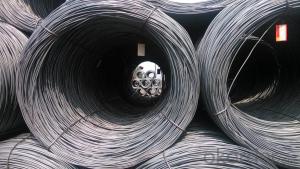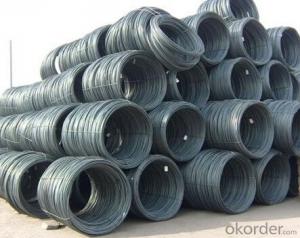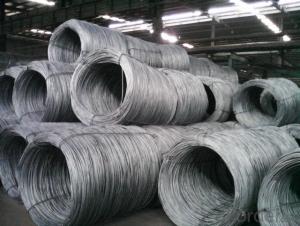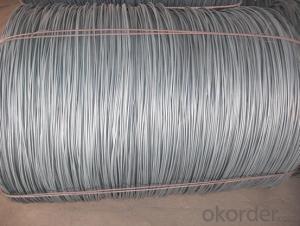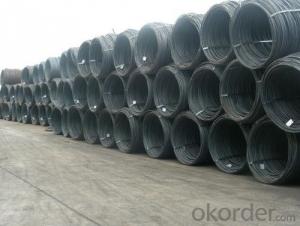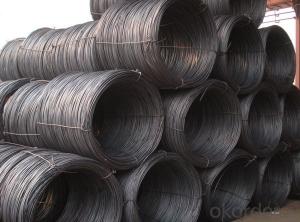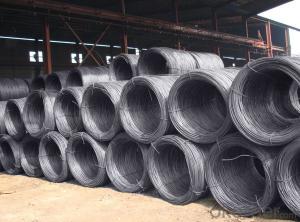Wire Rod 5.5MM-14MM SAE 1006 Or SAE1008 High Quality Hot Rolled
- Loading Port:
- China Main Port
- Payment Terms:
- TT or LC
- Min Order Qty:
- -
- Supply Capability:
- -
OKorder Service Pledge
OKorder Financial Service
You Might Also Like
Product Description:
OKorder is offering high quality Hot Rolled Steel I-Beams at great prices with worldwide shipping. Our supplier is a world-class manufacturer of steel, with our products utilized the world over. OKorder annually supplies products to European, North American and Asian markets. We provide quotations within 24 hours of receiving an inquiry and guarantee competitive prices.
Product Applications:
Deformed bar is widely used in buildings, bridges, roads and other engineering construction. Big to highways, railways, bridges, culverts, tunnels, public facilities such as flood control, dam, small to housing construction, beam, column, wall and the foundation of the plate, deformed bar is an integral structure material. With the development of world economy and the vigorous development of infrastructure construction, real estate, the demand for deformed bar will be larger and larger
Product Advantages:
OKorder's Steel I-Beams are durable, strong, and resist corrosion, exact size, regular package, chemical and mechanical properties are stable.
Main Product Features:
· Premium quality
· Prompt delivery & seaworthy packing (30 days after receiving deposit)
· Corrosion resistance
· Can be recycled and reused
· Mill test certification
· Professional Service
· Competitive pricing
Product Specifications:
Manufacture: Hot rolled
Grade: BS4449
Certificates: ISO, SGS, BV, CIQ
Diameter: 6mm,8mm,10mm,12mm,14mm,16mm,18mm,20mm,
22mm,25mm,28mm,32mm,36mm,40mm,50mm
Length: 6M, 9M,12M or as required
Packaging: Export packing, nude packing, bundled
Chemical Composition: (Please kindly find our chemistry of our material based on HRB500 as below for your information)
Grade | Technical data of the original chemical composition (%) | ||||||
C | Mn | Si | S | P | V | ||
HRB400 | ≤0.25 | ≤1.60 | ≤0.80 | ≤0.045 | ≤0.045 | 0.04-0.12 | |
Physical capability | |||||||
Yield Strength (N/cm²) | Tensile Strength (N/cm²) | Elongation (%) | |||||
≥400 | ≥570 | ≥14 | |||||
Theoretical weight and section area of each diameter as below for your information:
Diameter(mm) | Section area (mm²) | Mass(kg/m) | Weight of 12m bar(kg) |
6 | 28.27 | 0.222 | 2.664 |
8 | 50.27 | 0.395 | 4.74 |
10 | 78.54 | 0.617 | 7.404 |
12 | 113.1 | 0.888 | 10.656 |
14 | 153.9 | 1.21 | 14.52 |
16 | 201.1 | 1.58 | 18.96 |
18 | 254.5 | 2.00 | 24 |
20 | 314.2 | 2.47 | 29.64 |
22 | 380.1 | 2.98 | 35.76 |
25 | 490.9 | 3.85 | 46.2 |
28 | 615.8 | 4.83 | 57.96 |
32 | 804.2 | 6.31 | 75.72 |
36 | 1018 | 7.99 | 98.88 |
40 | 1257 | 9.87 | 118.44 |
50 | 1964 | 15.42 | 185.04 |
FAQ:
Q1: Why buy Materials & Equipment from OKorder.com?
A1: All products offered byOKorder.com are carefully selected from China's most reliable manufacturing enterprises. Through its ISO certifications, OKorder.com adheres to the highest standards and a commitment to supply chain safety and customer satisfaction.
Q2: What makes stainless steel stainless?
A2: Stainless steel must contain at least 10.5 % chromium. It is this element that reacts with the oxygen in the air to form a complex chrome-oxide surface layer that is invisible but strong enough to prevent further oxygen from "staining" (rusting) the surface. Higher levels of chromium and the addition of other alloying elements such as nickel and molybdenum enhance this surface layer and improve the corrosion resistance of the stainless material.
Q3: Can stainless steel rust?
A3: Stainless does not "rust" as you think of regular steel rusting with a red oxide on the surface that flakes off. If you see red rust it is probably due to some iron particles that have contaminated the surface of the stainless steel and it is these iron particles that are rusting. Look at the source of the rusting and see if you can remove it from the surface.
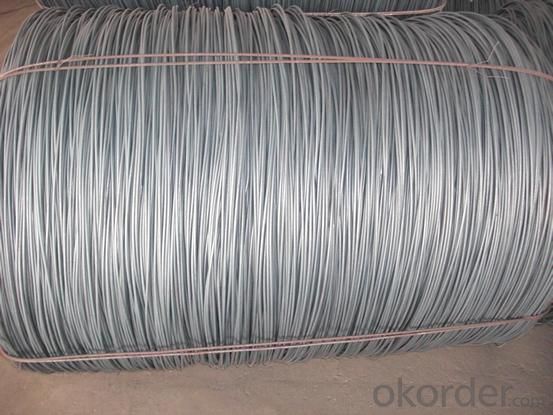
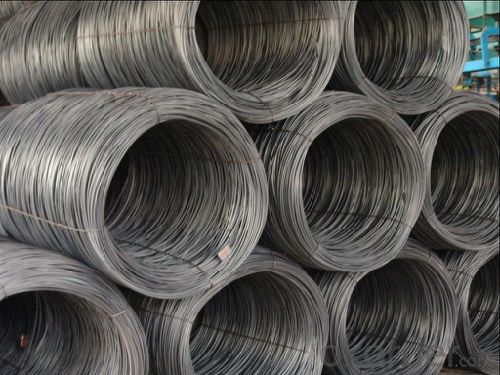
- Q: How is steel wire rod packaged for transportation?
- Steel wire rod is typically packaged for transportation by being bundled together and secured with steel strapping or wire ties. The bundles are then stacked on wooden pallets or loaded into steel crates for added protection. Additionally, some manufacturers may opt for further packaging using shrink wrap or plastic covers to safeguard the wire rod from moisture, dust, and other potential damages during transit.
- Q: How is steel wire rod used in the manufacturing of wire for musical instrument strings?
- Steel wire rod is a crucial raw material used in the manufacturing of wire for musical instrument strings. It is first drawn through a series of dies to achieve the desired diameter and shape. This process ensures that the wire is strong, durable, and has the necessary flexibility to produce the desired musical tones. The wire is then further processed, coated, and wound onto specific cores to create strings for various musical instruments, such as guitars, pianos, violins, and cellos. The quality and properties of the steel wire rod directly impact the sound quality, longevity, and performance of the instrument strings.
- Q: How is steel wire rod used in the manufacturing of wire racks?
- Wire racks rely heavily on steel wire rod, which acts as the main material for constructing the rack's framework and structure. To transform the wire rod into a long, thin wire, it goes through a series of steps such as heating, rolling, and drawing. This wire is then bent, shaped, and welded to create the different parts of the wire rack, including the sides, shelves, and supports. Due to its high tensile strength and durability, steel wire rod is a perfect choice for wire racks. It can withstand heavy loads and constant use without bending or breaking. Additionally, its corrosion resistance properties ensure that the wire rack remains strong and long-lasting, even in environments with high humidity or moisture exposure. The versatility of steel wire rod allows manufacturers to produce wire racks in a variety of sizes and designs to accommodate different storage needs. Its malleability enables easy manipulation to form various shapes, making it possible to create wire racks with adjustable shelves or collapsible features. This adaptability in design makes wire racks highly customizable for use in different settings, such as homes, offices, warehouses, or retail stores. Moreover, the use of steel wire rod in wire rack manufacturing facilitates efficient production processes. With automated machinery, the wire rod can be easily cut, shaped, and welded, reducing production time and costs. This ease of manufacturing enables mass production, ensuring a steady supply to meet market demands. In conclusion, steel wire rod is essential in manufacturing wire racks due to its strength, durability, and versatility. Its ability to be easily shaped, resistance to corrosion, and cost-effectiveness make it an ideal material for creating wire racks of various sizes and designs.
- Q: What are the different tensile testing methods for steel wire rod?
- Some common tensile testing methods for steel wire rod include the straightening and tensile testing method, the axial tensile testing method, and the wire drawing tensile testing method.
- Q: What are the different types of steel wire rod coatings used for increased corrosion resistance?
- There are several types of steel wire rod coatings used for increased corrosion resistance, including zinc coating, galvanized coating, and epoxy coating. Zinc coating, also known as galvanizing, involves applying a layer of zinc to the surface of the steel wire rod through a hot-dip or electroplating process. Galvanized coating is a similar process that provides a thicker layer of zinc, offering enhanced protection against corrosion. Epoxy coating involves applying a layer of epoxy resin to the steel wire rod, which forms a protective barrier against moisture and other corrosive elements. These coatings help to extend the lifespan and durability of the steel wire rod in various applications.
- Q: How is the weldability of steel wire rod evaluated?
- The weldability of steel wire rod is evaluated using various techniques and criteria. One of the key factors in assessing weldability is the chemical composition of the steel wire rod. The presence of certain elements, such as carbon, sulfur, and phosphorus, can significantly impact the weldability of the material. Additionally, the mechanical properties of the steel wire rod, such as its tensile strength, ductility, and toughness, are important considerations. These properties can affect the quality and integrity of the weld joint. Another factor to evaluate weldability is the surface condition of the steel wire rod. Any contaminants or impurities on the surface can negatively affect the weldability and lead to defects in the weld. Furthermore, the welding process and parameters used play a crucial role in determining the weldability of steel wire rod. Factors such as heat input, welding speed, and shielding gas selection need to be optimized to ensure proper fusion and minimize the risk of defects. To evaluate the weldability, various tests and inspections are conducted. These include visual examination of the weld for defects like cracks, porosity, or lack of fusion. Non-destructive testing methods like ultrasonic testing or radiography can be used to detect any internal flaws or inconsistencies. Additionally, mechanical tests like tensile and bend testing are performed to evaluate the strength and ductility of the weld joint. These tests help assess the overall quality and performance of the welded steel wire rod. In summary, the weldability of steel wire rod is evaluated by considering factors such as chemical composition, mechanical properties, surface condition, welding process, and conducting tests and inspections to ensure the quality and integrity of the weld joint.
- Q: How is the bending properties of steel wire rod tested?
- The bending properties of steel wire rod are typically tested through a method called the bend test. In this test, a sample of the wire rod is bent to a specific angle or curvature and then examined for any signs of cracking or breaking. The test is conducted by securing one end of the wire rod and applying a force to the other end to bend it. The amount of force required to achieve the desired bend is measured, and the wire rod is visually inspected for any signs of deformation or fracture. Additionally, the test may involve measuring the diameter of the wire rod before and after bending to assess any changes in its physical properties. The bend test provides valuable information about the flexibility and ductility of the steel wire rod, which is crucial in determining its suitability for various applications.
- Q: Can steel wire rod be recycled?
- Certainly, the recycling of steel wire rod is possible. Steel, being a material highly amenable to recycling, can undergo a rather uncomplicated recycling procedure when it comes to steel wire rod. Generally, the recycling process entails the gathering of discarded steel wire rod, its subsequent separation from any impurities, and finally, its melting to be reshaped into fresh steel goods. Recycling steel wire rod aids in the preservation of natural resources, diminishes the necessity for mining and producing novel steel, and additionally, yields environmental advantages by curbing greenhouse gas emissions and lowering energy consumption linked to the manufacture of new steel.
- Q: What are the advantages of using steel wire rod in agricultural applications?
- There are several advantages of using steel wire rod in agricultural applications. Firstly, steel wire rod is known for its strength and durability, making it suitable for heavy-duty tasks in the agricultural sector. It can withstand harsh weather conditions, heavy loads, and resist corrosion, ensuring a long lifespan. Secondly, steel wire rod is highly versatile, allowing it to be used in various applications such as fencing, trellising, and support structures. Its flexibility enables farmers to adapt it to their specific needs. Additionally, steel wire rod is cost-effective as it requires minimal maintenance and replacement, reducing long-term expenses. Lastly, steel wire rod is readily available and easily accessible, making it a convenient choice for agricultural operations.
- Q: How is steel wire rod bundled and packaged for transportation?
- Steel wire rods are bundled and packaged for transportation to ensure their safety and ease of handling. There are several methods commonly used for bundling and packaging steel wire rods. One common method is to bundle the rods together using steel straps or wires. The rods are typically arranged in a neat stack, and the straps or wires are tightly wrapped around the bundle to hold the rods securely in place. This bundling method helps to prevent the rods from shifting or rolling during transportation, reducing the risk of damage. In addition to bundling, steel wire rods are often packaged in wooden crates or pallets for added protection. These crates or pallets provide a sturdy and stable base for the bundled rods, making it easier to lift and move them using forklifts or other handling equipment. The crates or pallets also shield the rods from direct contact with the ground, minimizing the risk of corrosion or other damage. To further protect steel wire rods during transportation, they may be wrapped in plastic or shrink-wrap. This additional layer of packaging helps to shield the rods from moisture, dust, and other contaminants that could potentially cause corrosion or surface damage. Labels and markings are also applied to the bundles and packaging to provide important information about the contents, such as the type and grade of steel, the quantity of rods, and any specific handling instructions. These labels and markings assist in the efficient and accurate identification and handling of the steel wire rods during transportation and storage. Overall, bundling and packaging steel wire rods for transportation involves securing the rods together using steel straps or wires, placing them in wooden crates or pallets, and adding additional protection through plastic or shrink-wrap. This ensures that the rods are well-protected, organized, and easily handled throughout the transportation process.
Send your message to us
Wire Rod 5.5MM-14MM SAE 1006 Or SAE1008 High Quality Hot Rolled
- Loading Port:
- China Main Port
- Payment Terms:
- TT or LC
- Min Order Qty:
- -
- Supply Capability:
- -
OKorder Service Pledge
OKorder Financial Service
Similar products
Hot products
Hot Searches
Related keywords













